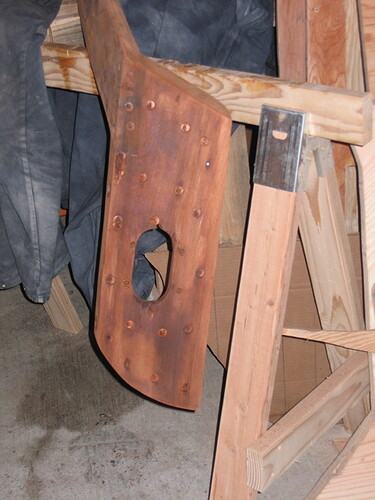All,
I have heard of this problem before with several types of wood. The same can happen with some Oaks and stainless, Birch and brass, Poplar and brass, Mahogany brass/red bronzes, teak and nickel plated steel. I do not know the exact reason, but it’s kind of hit-or-miss. With woods being living things, a bronze screw might discolor the wood from one tree, but not that from its neighbor.
In my W32, I have mahogany ply bulkheads. A previous owner had brass lamps mounted to two bulkheads, both with bronze screws. When I removed the lamp, one had three clean holes, the other three badly discolored holes. Different bulkheads, different sheets of wood, different trees. The same owner put stainless into the red oak headliner in a few places. In that case, all of the holes discolored (seems more prominent in Oaks/stainless).
Anyway, I don’t think simply smearing epoxy into the hole will work. To stop it, the fastener can’t touch the wood, and as much as we want to think bedding will keep the screw from it, chances are that it will wrigle its way into contact at some point. So you’re probably better to either use a different metal, or:
overdrill the hole by about 50%, put some thinned epoxy in the hole and let it setup (but not fully cure as you want the next step to have a chemical bond). Then either fill the hole with thickened epoxy, drilling and tapping it for your fastener once cured, or bed the fastener in it to cure in place. If you do the later, be sure to put a release agent on the screw (wax, lotion, etc.) I suggest the bedding method as it removes the challend of tapping brittle epoxy. If you have to do it that way though, you can heat your tap with a torch to keep it froshipping rhe epoxy (too hot will melt epoxy).
If you’re concerned about the look of the epoxy plug (white when thickened with colloidal silica or mishmash), add a few drops of brown, and one of red, acrylic paint, and/or do half of the thickening with mahogany sanding dust (but still use some glass fibers for strength) This will help it blend in.
If you just paint the wood with a fastener in it that is causing the discoloration, it will likely cause the paint to chip or bubble in the area. Someone told me that the process creates some sort of acid that promotes gassing.
Hope this helps!
Aaron N.
